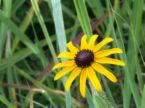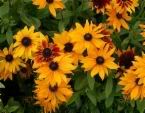

Scientific Name
Rudbeckia hirta
Uses of Blackeyed Susan: Landscaping, Medicinal, Culinary, etc...
Erosion control: Black-eyed Susan is an important component in critical area treatment plantings along with grasses, legumes, and other forbs when used along road cuts, hillsides, and other areas subject to erosion.
Wildlife: This plant offers protection and food to several song and game birds.
Recreation and beautification:Black-eyed Susan can be used for landscaping and in wildflower gardens.
General Characteristics
Rudbeckia hirta L., black-eyed Susan, is a biennial forb about 1 m tall with yellow ray flowers and dark brown spherical centers. After germination, the seedling grows into a rosette with oblong leaves. Sometimes flower stalks will appear in the first summer, but typically black-eyed Susan blooms from June to September of the second year. After flowering and seed maturation, the plants die. The seed is very small (1,746,000 per pound) and black, about 2 mm long and 0.5 mm in diameter.
Required Growing Conditions
Black-eyed Susan is naturalized in most of the states east of Kansas and the bordering areas of Canada. It is adapted throughout the Northeast on soils with a drainage classification range from well-drained to somewhat poorly drained. It will perform acceptably on droughty soils during years with average or above rainfall, but best growth is achieved on sandy, well drained sites. It is winter hardy in areas where low temperatures are between -30 ° and -20 °F.
Cultivation and Care
Black-eyed Susan is easily established with most critical area seeding techniques. Generally ½ lb. of seed per acre is sufficient in mixes with conservation grasses, legumes, and other forbs. Where the intent is to maximize the impact of the forb component, utilize bunchgrasses rather than aggressively spreading grasses such as reed canarygrass or bromegrass. Once established, new seedlings will be produced from the preceding crop; the stand may perpetuate itself indefinitely.
General Upkeep and Control
After establishment, competing perennial vegetation should be controlled through the use of mechanical or chemical practices. If competing vegetation is not controlled, one will observe a decrease in the number of black-eyed Susan plants.
Pests and Potential Problems There are no major insect or disease pests of black-eyed Susan. Stands can be reduced by powdery mildew and damping-off organisms.
Cultivars, Improved, and Selected Materials (and area of origin) 'Golden Jubilee' black-eyed Susan was released by the Big Flats Plant Materials Center in 1985. It is typical of the species except slightly shorter in height with a longer bloom period. It was not selected for its flower size or color. 'Golden Jubilee' is the only cultivar of black-eyed Susan that has proven adaptation throughout the Northeast for conservation use. The original collection area of 'Golden Jubilee' was near Manchester, Vermont. Foundation seed is distributed to commercial producers by the Big Flats PMC in Corning, NY. Black-eyed Susan is readily available from commercial sources.





0 comments: